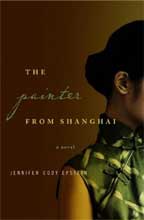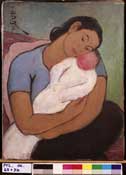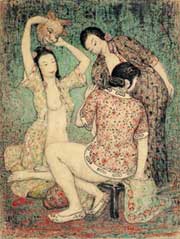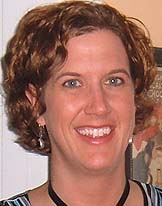Based in New York, Jennifer Cody Epstein has written for Self, the Wall Street Journal, and the Chicago Tribune. She has published short fiction in several journals and was a finalist in a Glimmer Train fiction contest. Her first novel, The Painter from Shanghai, is released this month.
1.Welcome to WOW!, Jennifer. So, your first novel, The Painter from Shanghai, is coming out this month. How are you feeling about its release?
Very excited! It’s both a relief and somewhat terrifying to have it finally about to happen.
2. Congratulations! All novelists can probably empathize with your mixed emotions. How long did it take you to write the novel?z`
From conception to completion, about 10 years.
3. What a long period of time to invest in one project! Tell us how you chose your subject for this novel.
In truth, the subject came to me somewhat unexpectedly. I was visiting an exhibition on modern Chinese art at the Guggengheim in 1998, and I saw one of Pan Yuliang’s paintings there. It just drew me—her style, her face, her extraordinary story. When my husband suggested that it should be my first novel, I looked at him like he was crazy, but (obviously) the subject grew on me.
4. So, the subject is the real artist, Pan Yuliang. How much of the novel is based on her actual life?
The broad strokes are more or less in keeping with what I was able to confirm about her life—when and where she was born, when she entered and left the brothel, when she married, when she went abroad, came home, left for good. Though (as several experts confirmed for me) the facts of her life are so obscure, even in Chinese, there was a lot of room to expound and imagine. In some ways, it was a perfect subject for a fictionalized biography.
5. It sounds like she had a fascinating life. Did you use Yuliang’s paintings to inspire your story?
Absolutely. It was, as I said, a Pan Yuliang painting that first brought me to the subject, though it took me well over a year to actually build up the temerity to begin writing about her. But, throughout that time, I had her portrait as a screensaver, so she was pretty much the first thing I saw when I turned on my computer. I also had several color copies of her work—“Motherlove” and a couple others—taped over my desk.
6. I read on your website that you did a lot of research for this book. How did you know when to stop the research and start the writing?
That’s always the trick, isn’t it? One’s tempted to go on researching forever. In some ways, it’s so much easier than the writing. But, after a certain point, I began to realize that—unlike in nonfiction—no matter how much I researched, I wouldn’t use more than maybe 15%. If that. And, even then, I ended up going back and cutting stuff out. That helped me to keep it in perspective—as did constantly reminding myself that this is, after all, fiction!

“When my husband suggested that it should be my first novel, I looked at him like he was crazy, but (obviously) the subject grew on me.”
7. While you were writing and researching this book, you were also raising children. How did these two worlds work together?
It depended on the day! There were certainly points when I would have said they didn’t work at all. There never seemed to be enough time, quiet, or space to work. Even when I could sit down, in the very early days, I was so exhausted, I could barely see my computer screen.
Having said that, I actually think motherhood and writing can be a tremendously productive pairing, as one is so completely cerebral and the other so intensely physical. My kids are a terrific way to get me out of my head, and my writing is a complete escape from motherhood. (Unless, of course, I’m writing about motherhood, which I seem to do a lot!) As a writing mother, you also have to be tremendously organized—there’s no time for the luxury of writer’s block, for example, if you know you’ve only got the two hours a nap provides to work within.
Organization was never one of my strong points prepartum. But, after I had my kids, I got exponentially better. I was repeatedly amazed while at graduate school that I seemed to be getting so much more done than a lot of people, who had unlimited time on their hands—because I had to.

“I actually think motherhood and writing can be a tremendously productive pairing, as one is so completely cerebral and the other so intensely physical.”
8. That’s a very positive way to look at balancing your life. Thanks for sharing that with us. What are the challenges of writing historical fiction, then?
I think you nailed one of them above—knowing how to balance the research with the writing. The biggest pitfall, for me, is getting showy with your knowledge and throwing things in that don’t work with the book’s own story arc. I love Chinese history, and there were so many times when I discovered something or someone fascinating in my research and tried desperately to fit it in.
But in the end, the story kind of chooses its own elements—things that aren’t immediate to it will end up sticking out like bent nails and mar the whole. One of the best pieces of advice I received from a writing mentor was to not be afraid to take things out and to not see it as a waste. It’s all part of how you achieve your ends, and the ends are almost always better for having had that experience of researching, writing and editing.
9. Now that we know a great deal about the challenges, what are the joys of writing historical fiction?
For me, it’s the joining of two loves of mine—history and fiction. I love the research part, and I love crafting something new out of old material, so to speak. I also love the sheer selfishness it allows me as a writer—I can choose the topics, places, and characters in history that intrigue me, and basically spend my workday imagining how things were for them. It’s a little like time travel.
10. What do you want readers to know about your debut novel before they pick it up to read?
I guess the most important thing to me is that while its subject tends to lend it to comparison to other books about women and Asian history (Memoirs of a Geisha, for example, which happens to be a fabulous book, so I’m very flattered), I’d also like it to be seen on its own terms. I’d like to think that neither my style nor my subject are very similar to anything else out there that has been written, eastern or western (although I guess most authors probably feel this way.) Also, it is historical fiction—emphasis on the fiction. This is not a factual account of Pan Yuliang’s life, but a re-imagining that I’m hoping will bring both readers and myself somewhere nearer to her extraordinary spirit, if not her actual, extraordinary life.
11.How much say did you have in the title of your debut novel and its cover, which is just absolutely beautiful?
Actually, I didn’t come up with either! I was completely stymied on the title—we had one earlier that I liked. It was connected to a thread that came out of the book after edit. Then we came up with a bunch of others that really didn’t work, and finally the book’s UK editor (at Viking), after truly exemplary determination, came up with “The Painter from Shanghai” (though actually for some reason it’s “The Painter of Shanghai” in the UK.)
I will admit that I wasn’t wowed (no pun intended) by it initially—I’d been hoping for something more poetic or elliptical, I guess. And technically, Pan wasn’t actually from Shanghai. But after a lot of thought, it grew on me, and my editors and agent felt that it gave a good sense of the book’s scope and subject. And the cover is from Norton’s extremely talented art department—I was just over the moon when I saw it. I think it’s perfect.

“I can choose the topics, places, and characters in history that intrigue me, and basically spend my workday imagining how things were for them.”
12. What type of marketing are you doing for this novel? What have you found to be successful?
I’ve been working with Norton in the US, and they’ve been focusing mostly on review attention and book placement in bookstores. We’ve also been exploring the Internet—Authorbuzz, for example, which is a great service. It will “buzz” your book to library and book-group newsletters. And I’ve been on Goodreads.com for a while, which is not only a really fun site (you can exchange book thoughts with people) but also is a good place to get Painter out there.
13. Most of us have dreamed of writing and publishing a novel for a long time. When did you decide you wanted to write a novel?
I think from age 11, when I was first chosen (in Mr. Kahane’s fifth-grade class at Brown Middle School in Wellesley, Mass) for “Authors Corner.” I had this fantasy-inspired, twelve-page story about children in a magic world. I copied it onto yellow, lined paper, and it was posted on the wall outside the principal’s office, along with a black-and-white photo of me, looking very authorially broody. It all just felt right to me. I’m not really sure why it took me so long to actually get to it professionally.
14. With all of your recent experience, what tips can you give readers, who want to publish their first novel?
Not to give up!! It can be an incredibly discouraging and isolating process, and you are always going to have people telling you either you can’t do it, or you are doing a lousy job. You need to build a thick skin about your work (not easy for most of us, particularly writers!) and keep in mind that it’s a marathon, not a sprint.
One of my friends was just heroic about the process—she was turned down by every single agent, but the last one she sent her manuscript to was taken on by the agent’s assistant. Then, she was turned down by several publishers. Now, her book is coming out, it’s getting myriad distinctions and glowing reviews, and she’s deliriously happy. I have another friend—a YA author—who worked forever on her first book, which was rejected by everyone. Her second one was a huge hit, and then she ended up selling the first one as part of a several-book deal, I think. There are so many stories like that, and you really need to keep them in mind when you’re pounding the pavement with your first-born manuscript.
15. Speaking of agents, do you have an agent? If yes, why do you think agents are helpful?
My agent is Elizabeth Sheinkman at Curtis Brown, and she’s been absolutely essential to my career. On a very basic level, she simply knows the business, which is something most authors aren’t going to have an edge in. And, she’s also got great instincts and a wonderful attitude—she’s always ready to talk you down or up, depending on what you need. I’m very lucky.
“Anything you can do to differentiate yourself from the masses is helpful. Use your contacts.”
16.You have also had success writing for magazines—fiction and nonfiction, according to your bio. What are some tips you can give WOW! readers about writing for national magazines?
That it’s HARD! The national magazines can be somewhat of a meat grinder—once you get in, you have to be prepared to be very heavily edited and worked-over to meet the very specific styles of each publication. And you can’t get discouraged! You just have to keep pitching. Don’t be afraid to follow up. Also, anything at all you can do to differentiate yourself from the masses is helpful. Use your contacts. .
17. You also write short stories. Are your short stories generally set in Asia and in the past, or do you write about different settings for your shorter works?
Some in Asia, some in the states. One in Italy, where I’ve lived for a year and which I love. (I was thrilled to hear Rizzoli is publishing my book!) Most of my stories relate to families in some context; I’m working on a collection right now (very slowly) that is linked throughout by the theme of motherhood.
18. Are you working on your next novel? If so, what is the subject?
I’m researching it, for the most part. It’s probably going to be set in Japan, during World War II. I’m still narrowing down the subject, but for the time being, I’m doing a lot of re-reading of Japanese novels I love. I am also trying to recapture my Japanese. I used to be pretty fluent, but I haven’t used it for about fifteen years. Between neglect and motherhood, it’s gone well past rusty. “Ossified” might be more like it.
19. What is your writing routine like?
These days, it’s pretty civilized. I have a sitter, and the girls are in school, so I usually can carve out about 4 hours or so between 10:00 a.m. and 5:00 p.m. to work. It used to be pretty crazy, though—when my oldest daughter was a baby. The only time I could really count on quiet was after the first feeding (at 5 a.m.), and then whenever she napped. So, I traveled with my history books and my computer with me pretty much all the time, and I would pull into the nearest café the minute she dropped off.
20.Do you belong to a critique group? Why or why not?
I do. I think collaboration and community are very important in writing. For one thing, it gets you used to criticism, which as I said, is essential. But more importantly, it’s really heartening to be with other people who are going through the same process as you. I loved graduate school for the same reason. It’s a bit like belonging to a new mother’s group after you’ve had a baby. It’s very easy to think you’re simply insane unless you spend time with other people who live the same life.
WOW: Thank you, Jennifer, for sharing your experiences and knowledge with us. Good luck with your debut novel. We wish you the best. Check out The Painter from Shanghai, published by W.W. Norton and Company this month!
To learn more about Jennifer Cody Epstein, visit her website: https://www.jennifercodyepstein.com
***

Margo Dill is a freelance writer and elementary school teacher, living in Mahomet, Illinois. Her work has appeared in publications such as Grit, Pockets, Missouri Life, ByLine Magazine, and The News-Gazette. Her first book, a middle-grade historical novel, will be published by White Mane Kids in 2009. When she's not writing, she loves spending time with her husband, stepson, and two dogs—Charlie, a boxer, and Hush Puppy, a basset hound.
Margo is also part of Team WOW! You can read her previous article in WOW!’s September issue: Writers' Conferences: 5 Reasons You Should Go NOW and How To Get the Most for Your Money and her previous 20 Questions interview with Bobbi Smith.